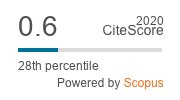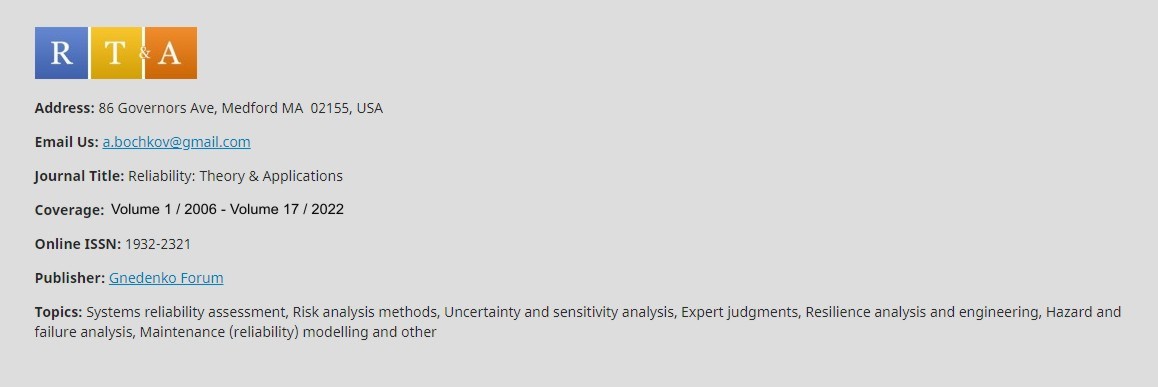|
About Us | Submission | Editorial Team | Privacy Statement | Current Issue | Templates & Author Guidelines | Archives | Contacts
|
||
|
|
D. Gnedenko, M. Yastrebenetsky
Vladimir Semenovich Korolyuk, an outstanding Ukrainian mathematician, whose main work is related to probability theory, mathematical statistics, approximate and numerical methods, died on June 4, 2020 at the age of 95. V.S.Korolyuk published about 350 scientific works, including about 20 monographs. Vladimir Semenovich Korolyuk was the Honored Worker of Science and Technology of Ukraine (1998), the laureate of the State Prize of Ukraine in the field of science and technology (1978, 2003), Prizes of the Academy of Sciences of Ukraine named after N. M. Krylov (1976), V. M. Glushkov (1988), N. N. Bogolyubov (1995), M. V. Ostrogradskii (2002).
DOI: https://doi.org/10.24411/1932-2321-2020-13001
A. Kostogryzov
The estimations of critical operation quality deterioration for “Smart” Engineering Systems (SES) are analyzed considering impacts on SES operation correctness and reliability. Basic probabilistic models for the predictive analysis of SES operation are proposed. The effects are illustrated by examples that cover the comparisons of SES, acting as medium-level and skilled operators, the estimation of SES operation without and with considering correctness and reliability, rationale requirements to admissible level for the errors of analysis, predictions of the risks of critical SES operation quality deterioration, sensitivity estimation of predicted risks, the efficiency in practice applications. The novelty is formed from (1) the described methodology for risks of critical operation quality deterioration for SES, considering complexity and uncertainties for SES operation correctness and reliability, (2) the comparable impacts on SES operation quality from failures (reliability) and errors of the 1st and 2nd types (correctness), proved by probabilistic modeling, (3) the achievable levels about 0.999-0.9997 and more for probability of SES operation correctness and reliability and about 0.01 – 0.001 and less for probability of critical SES operation quality deterioration during 1 year, which characterizes risk for identical consequences.
DOI: https://doi.org/10.24411/1932-2321-2020-13002
Aditya Tiwary, Swati Tiwary EVALUATION OF CUSTOMER ORIENTATED INDICES AND RELIABILITY STUDY OF ELECTRICAL FEEDER SYSTEM
Reliability evaluation of a system or component or element is very important in order to predict its availability and other relevant indices. Reliability is the parameter, which tells about the availability of the system under proper working conditions for a given period of time. The study of different reliability indices are very important considering the complex and uncertain nature of the power system. In this paper reliability evaluation of the electrical feeder, system is presented. This paper also evaluates basic indices such as average failure rate, average outage time and average annual outage time. Along with basic indices, customer orientated indices such as system average interruption frequency index, system average interruption duration index and customer average interruption duration index of an electrical feeder system is also evaluated.
DOI: https://doi.org/10.24411/1932-2321-2020-13003
G. Tsitsiashvili, Y. Kharchenko SYNERGETIC EFFECTS IN APPLIED POISSON FLOW MODELS
In this paper, we consider applied models of Poisson
flow, in which synergetic effects are identified.
The synergistic effect here is understood as a
significant increase/decrease of the efficiency of
the simulated system, while increasing the flow rate
and a certain additional parameter of the model.
Three applied Poissom flow models are considered.
First of them is application of Boolean model in
powder metallurgy. Second describes process of
DOI: https://doi.org/10.24411/1932-2321-2020-13004
Beenu Thomas, V. M. Chacko
EXPONENTIAL-GAMMA (
Lifetime distributions for many components usually have a bathtub shape for its failure rate function in practice. However, there are a very few distribution have bathtub shaped failure rate function. Models with bathtub-shaped failure rate functions are useful in reliability analysis, particularly in reliability related decision making, cost analysis and burn-in analysis. When considering a failure mechanism, the failure of units in system may be due to random failure occurred by change in temperature, voltage, jurking etc or due to ageing. This paper study on a distribution, which is a mixture of Exponential and Gamma (3) distribution, which have bathtub shaped failure rate function. Moments, skewness, kurtosis, moment generating function, characteristic function are derived. Renyi entroy, Lorenz curve and Gini index are obtained. Reliability of stress-strength model is derived. Distribution of maximum and minimum order statistics are obtained. We have obtained maximum likelihood estimators. A simulation study is conducted to illustrate the performance of the accuracy of the estimation method used. Application is illustrated using real data.
DOI: https://doi.org/10.24411/1932-2321-2020-13005
Aditya Tiwary
This paper describes a non-parametric bootstrap technique and Monte Carlo simulation technique to evaluate MTTF and reliability for a complex network, where components have different failure density functions. Algorithm for complete reliability analysis with boot strapping and Monte Carlo simulation (MCS) technique for the complex network has been developed. The algorithm has been implemented on a bridge network. The result obtained has been compared with those obtained using MCS.
DOI: https://doi.org/10.24411/1932-2321-2020-13006
M. Uspensky CONTRIBUTION OF HARDWARE, SOFTWARE, AND TRAFFIC TO THE WAMS COMMUNICATION NETWORK AVAILABILITY
Modes of the power system can now be controlled by use of a Wide Area Measurement Systems (WAMS). It is based on the Phasor Measurement Unit (PMU), connected by an information network covering a significant territory. The hardware reliability of such a network is determined to a big extend by the reliability of storage media (optical fiber, radio waves, etc.) and by the devices that ensure their operation - Phasor Data Concentrator (PDC). The paper proposes an approach to determining the parameters of reliability on the example of a 10-bus power system. The ways to improve the hardware reliability of the information network are considered.
DOI: https://doi.org/10.24411/1932-2321-2020-13007
Jismi Mathew, Sebastian George LENGTH BIASED EXPONENTIAL DISTRIBUTION AS A RELIABILITY MODEL: A BAYESIAN APPROACH
In this paper, mathematical properties of Length biased Exponential distribution via Bayesian approach are derived under various loss functions. These properties include Bayes estimators and posterior risks for the simulation study. The comparison was made based on the performance of the Bayes estimate for the parameter under different loss functions with respect to the posterior risk. Also, obtained the reliability characteristics of this distribution.
DOI: https://doi.org/10.24411/1932-2321-2020-13008
Malyala Sathya Sai Dattu, Shaik Nayeem COMPOSITE DISC BRAKE DESIGN AND ANALYSIS
Brakes are the major components of the automobiles which are used to reduce the speed of the vehicle or to hold in the desired position by ceasing the motion of the vehicle. During braking, due to vehicle kinetic energy of the vehicle and the mechanical forces applied on the Disc leads to a temperature rise of the contact pairs of the discs results in heat dissipation. This project aims to select the best design of a Disc brake using the TOPSIS method and to develop a design of composite Disc and develop a methodology to check the durability under thermo-mechanical cyclic stresses. Initially, 5 models of the discs having various types of vents are selected and their durability was analyzed and the best Disc geometry was selected by using the ranking method, TOPSIS. The best-selected Disc design was analyzed with cast iron (Fe) and Titanium - cast iron metal matrix composite (Ti – Fe MMC) to sustain harsh working conditions. The Ti – Fe composites were prepared numerically by using MSC Digimat. The designed composite Disc brake is analyzed with existing material (Fe) and proposed Ti – MMC with Ti particle reinforcements in 5%, 10%, 15%, and 20% volume, for its sustainability using FEA and the results are compared and validated. The design of the composite brake is carried out in Solidworks Part Design and the thermo-mechanical analysis is carried out in ANSYS. From the results of thermal coupled with mechanical FE analysis (thermo-mechanical FEA) it is found that the Ti – Fe MMC 20% composite disc brake can work at temperatures up to 1050 K whereas the grey cast iron disc brake can only function up to 548 K.
DOI: https://doi.org/10.24411/1932-2321-2020-13009
Kamlesh Kumar Shukla A TRUNCATED TWO PARAMETER PRANAV DISTRIBUTION AND ITS APPLICATIONS
In this paper, two parameter truncated Pranav distribution has been proposed. Some statistical properties including moments, coefficient of variation, skewness and index of dispersion have been derived and presented graphically. Survival and Hazard functions are derived and its behaviors are presented graphically. Maximum likelihood method of estimation has been used to estimate the parameters of proposed model. Simulation study has also been carried out. A proposed distribution has been applied on two data sets and compares its superiority over two parameter and one parameter classical distributions.
DOI: https://doi.org/10.24411/1932-2321-2020-13010
Himanshu Pandey, Kushagra Mittal ANALOGY BETWEEN AGENT LESS MONITORING AND AGENT BASED MONITORING
There has been an ongoing war among Agent-based vs. Agentless control and management technologies in the IT Service Management sector. Several vendors claim to be agentless, and do not need any special deployment of agents. Someone else include the use of proprietary agents. Both strategies have pros and cons. This study explores the agents versus agentless approach to management of enterprise processes, looking at emerging developments in both technological advances and the industry. We have compared Agent Based and Agent Less Monitoring for two different scenarios on following parameters - Installation and depth of monitoring, Cost, Maintainance, Network Overhead, Server Overhead, Knowledge, Security.In scenario 1 we conclude that Agent based collector has edge over Agent less and in scenario 2 we conclude that Agent Less collector has edge over Agent Based
DOI: https://doi.org/10.24411/1932-2321-2020-13011
Priyanka Singh, U. K. Khedlekar, A. R. Nigwal OPTIMAL ORDER QUANTITY AND PRICING POLICIES FOR EPL MODEL WITH REWORK AND QUALITY INSPECTION
This article develops a three-echelon supply chain coordination policy composing of a supplier, a manufacturer, and a wholesaler. The economic production lot-size (EPL) model comprises of perfect and defective items, quality inspection, return policy and reworking of defective items by the manufacturer. The defective items produced are reworked at a cost just after the regular production time. Here, return policy is considered between the outside supplier and the supplier, and the manufacturer and the wholesaler. Also, we considered the production cost as a function of production rate. We have formulated the profit functions of each member of the supply chain and optimized the total profit function of the whole supply chain system. Next, we have shown that the profit function of each member is concave. A numerical example with graphical representation presented to illustrate the proposed model.
DOI: https://doi.org/10.24411/1932-2321-2020-13012
Ismail Muhammad Musa, Ibrahim Yusuf
A network system is designed in this paper. It has two labs connected in parallel with four units each; working under 3-out-of-4: G; policy, two servers connected in parallel working under 1-out-of-2: G; policy and a router. The labs, servers and the router are connected in series all together. By making use of a supplementary variable and Laplace transforms to varies measures of system reliability, the network system has been studied and evaluation of Sensitivity, Availability, Reliability, (Mean time to failure) MTTF, and cost analysis for particular values of the failure and repair rates is made. Conclusion has been done with computed results demonstrated by tables, figures and graphs.
DOI: https://doi.org/10.24411/1932-2321-2020-13013
|
Safety Research :
Safety, Risk, Reliability and Quality:
Statistic, Probability and Uncertainty :
|
|
|
|
|
|
|
||







.png)
.png)
